Health and Care: An Essay on Biological and Social Processes in Gender Development
VerifiedAdded on 2023/06/18
|8
|2486
|170
AI Summary
This essay explores the biological and social processes that influence gender development in health and care. It discusses the differences between sex and gender, the impact of socialization, and the role of biological factors in shaping gender identity.
Contribute Materials
Your contribution can guide someone’s learning journey. Share your
documents today.

HEALTH AND
CARE: AN ESSAY
CARE: AN ESSAY
Secure Best Marks with AI Grader
Need help grading? Try our AI Grader for instant feedback on your assignments.

Table of Contents
INTRODUCTION...........................................................................................................................3
MAIN BODY...................................................................................................................................3
CONCUSION..................................................................................................................................7
REFERENCES................................................................................................................................8
INTRODUCTION...........................................................................................................................3
MAIN BODY...................................................................................................................................3
CONCUSION..................................................................................................................................7
REFERENCES................................................................................................................................8
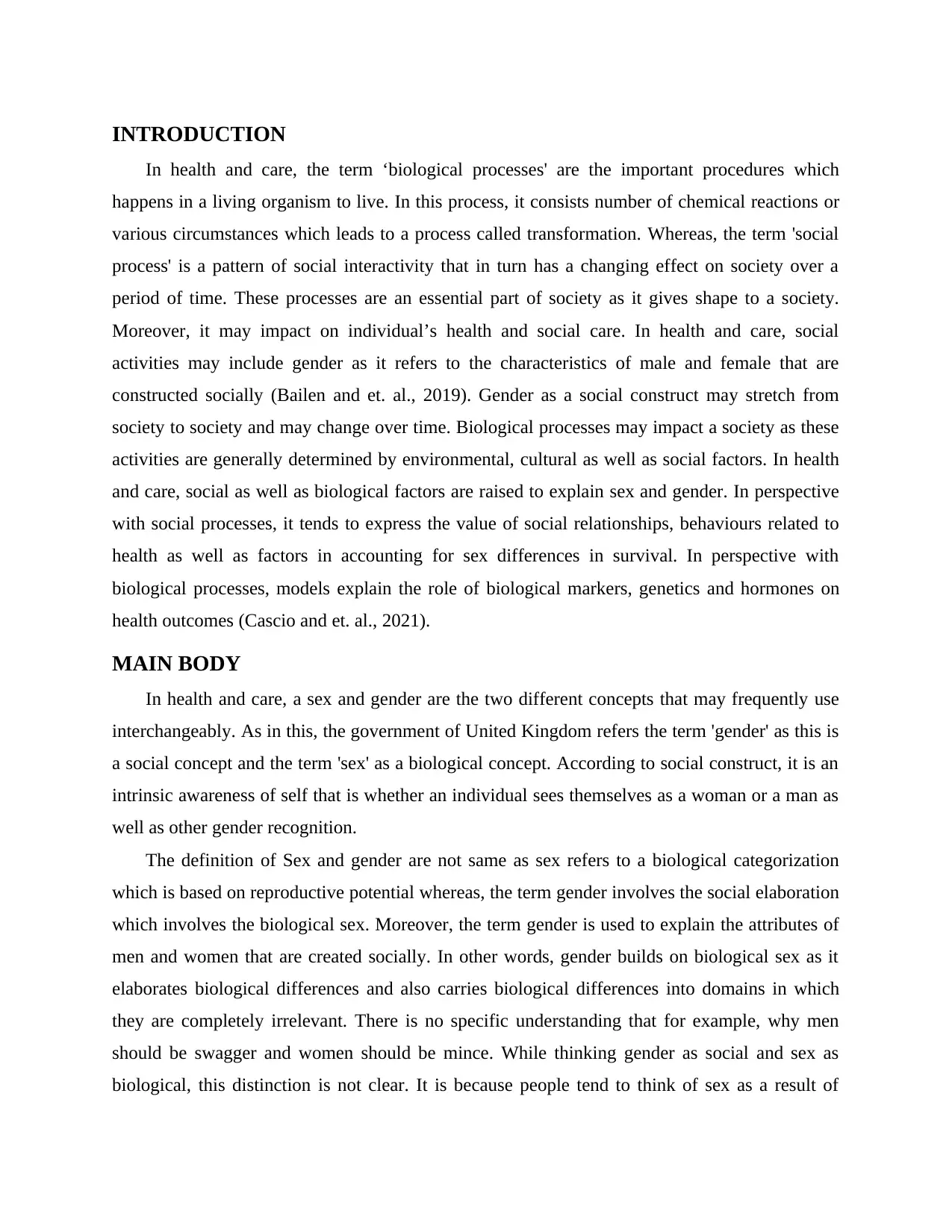
INTRODUCTION
In health and care, the term ‘biological processes' are the important procedures which
happens in a living organism to live. In this process, it consists number of chemical reactions or
various circumstances which leads to a process called transformation. Whereas, the term 'social
process' is a pattern of social interactivity that in turn has a changing effect on society over a
period of time. These processes are an essential part of society as it gives shape to a society.
Moreover, it may impact on individual’s health and social care. In health and care, social
activities may include gender as it refers to the characteristics of male and female that are
constructed socially (Bailen and et. al., 2019). Gender as a social construct may stretch from
society to society and may change over time. Biological processes may impact a society as these
activities are generally determined by environmental, cultural as well as social factors. In health
and care, social as well as biological factors are raised to explain sex and gender. In perspective
with social processes, it tends to express the value of social relationships, behaviours related to
health as well as factors in accounting for sex differences in survival. In perspective with
biological processes, models explain the role of biological markers, genetics and hormones on
health outcomes (Cascio and et. al., 2021).
MAIN BODY
In health and care, a sex and gender are the two different concepts that may frequently use
interchangeably. As in this, the government of United Kingdom refers the term 'gender' as this is
a social concept and the term 'sex' as a biological concept. According to social construct, it is an
intrinsic awareness of self that is whether an individual sees themselves as a woman or a man as
well as other gender recognition.
The definition of Sex and gender are not same as sex refers to a biological categorization
which is based on reproductive potential whereas, the term gender involves the social elaboration
which involves the biological sex. Moreover, the term gender is used to explain the attributes of
men and women that are created socially. In other words, gender builds on biological sex as it
elaborates biological differences and also carries biological differences into domains in which
they are completely irrelevant. There is no specific understanding that for example, why men
should be swagger and women should be mince. While thinking gender as social and sex as
biological, this distinction is not clear. It is because people tend to think of sex as a result of
In health and care, the term ‘biological processes' are the important procedures which
happens in a living organism to live. In this process, it consists number of chemical reactions or
various circumstances which leads to a process called transformation. Whereas, the term 'social
process' is a pattern of social interactivity that in turn has a changing effect on society over a
period of time. These processes are an essential part of society as it gives shape to a society.
Moreover, it may impact on individual’s health and social care. In health and care, social
activities may include gender as it refers to the characteristics of male and female that are
constructed socially (Bailen and et. al., 2019). Gender as a social construct may stretch from
society to society and may change over time. Biological processes may impact a society as these
activities are generally determined by environmental, cultural as well as social factors. In health
and care, social as well as biological factors are raised to explain sex and gender. In perspective
with social processes, it tends to express the value of social relationships, behaviours related to
health as well as factors in accounting for sex differences in survival. In perspective with
biological processes, models explain the role of biological markers, genetics and hormones on
health outcomes (Cascio and et. al., 2021).
MAIN BODY
In health and care, a sex and gender are the two different concepts that may frequently use
interchangeably. As in this, the government of United Kingdom refers the term 'gender' as this is
a social concept and the term 'sex' as a biological concept. According to social construct, it is an
intrinsic awareness of self that is whether an individual sees themselves as a woman or a man as
well as other gender recognition.
The definition of Sex and gender are not same as sex refers to a biological categorization
which is based on reproductive potential whereas, the term gender involves the social elaboration
which involves the biological sex. Moreover, the term gender is used to explain the attributes of
men and women that are created socially. In other words, gender builds on biological sex as it
elaborates biological differences and also carries biological differences into domains in which
they are completely irrelevant. There is no specific understanding that for example, why men
should be swagger and women should be mince. While thinking gender as social and sex as
biological, this distinction is not clear. It is because people tend to think of sex as a result of
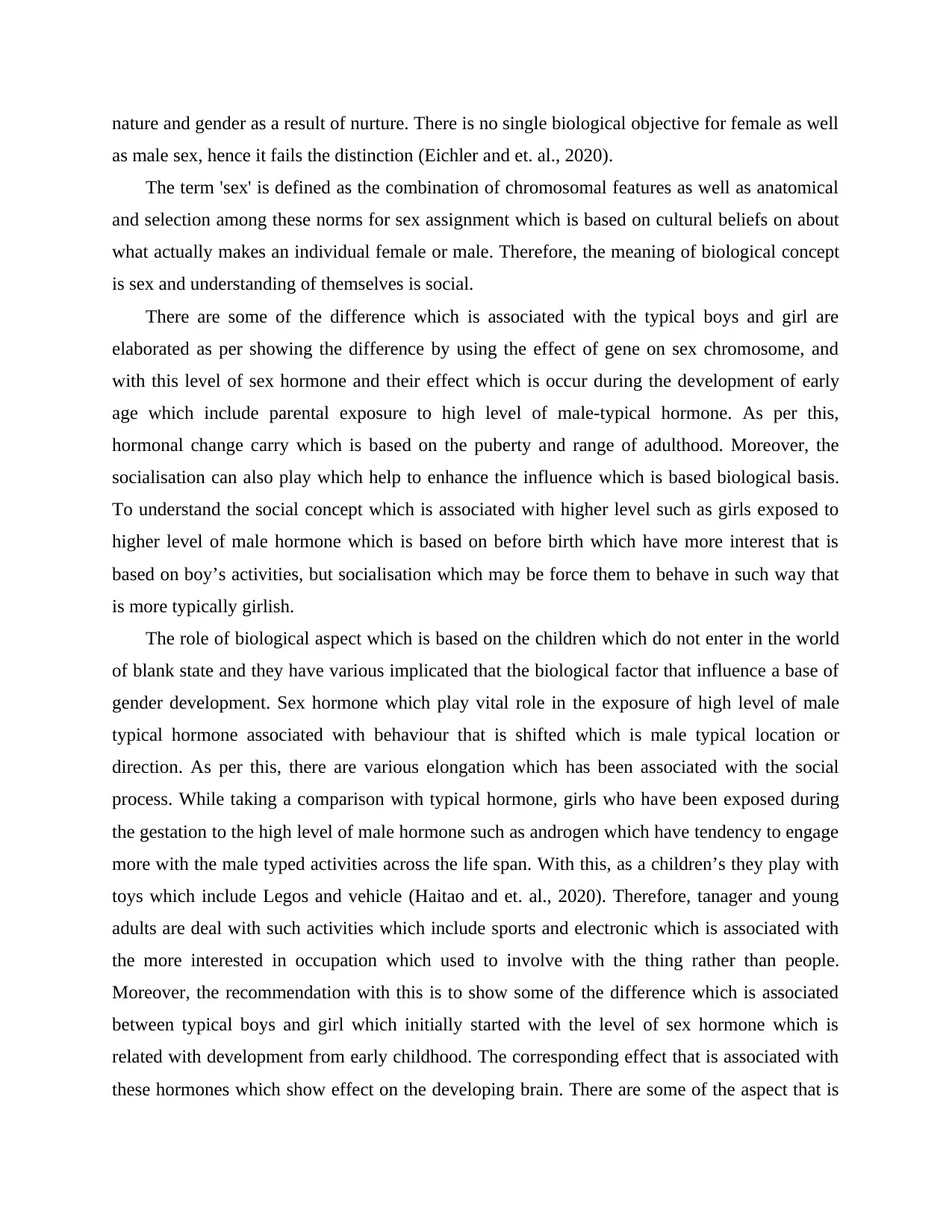
nature and gender as a result of nurture. There is no single biological objective for female as well
as male sex, hence it fails the distinction (Eichler and et. al., 2020).
The term 'sex' is defined as the combination of chromosomal features as well as anatomical
and selection among these norms for sex assignment which is based on cultural beliefs on about
what actually makes an individual female or male. Therefore, the meaning of biological concept
is sex and understanding of themselves is social.
There are some of the difference which is associated with the typical boys and girl are
elaborated as per showing the difference by using the effect of gene on sex chromosome, and
with this level of sex hormone and their effect which is occur during the development of early
age which include parental exposure to high level of male-typical hormone. As per this,
hormonal change carry which is based on the puberty and range of adulthood. Moreover, the
socialisation can also play which help to enhance the influence which is based biological basis.
To understand the social concept which is associated with higher level such as girls exposed to
higher level of male hormone which is based on before birth which have more interest that is
based on boy’s activities, but socialisation which may be force them to behave in such way that
is more typically girlish.
The role of biological aspect which is based on the children which do not enter in the world
of blank state and they have various implicated that the biological factor that influence a base of
gender development. Sex hormone which play vital role in the exposure of high level of male
typical hormone associated with behaviour that is shifted which is male typical location or
direction. As per this, there are various elongation which has been associated with the social
process. While taking a comparison with typical hormone, girls who have been exposed during
the gestation to the high level of male hormone such as androgen which have tendency to engage
more with the male typed activities across the life span. With this, as a children’s they play with
toys which include Legos and vehicle (Haitao and et. al., 2020). Therefore, tanager and young
adults are deal with such activities which include sports and electronic which is associated with
the more interested in occupation which used to involve with the thing rather than people.
Moreover, the recommendation with this is to show some of the difference which is associated
between typical boys and girl which initially started with the level of sex hormone which is
related with development from early childhood. The corresponding effect that is associated with
these hormones which show effect on the developing brain. There are some of the aspect that is
as male sex, hence it fails the distinction (Eichler and et. al., 2020).
The term 'sex' is defined as the combination of chromosomal features as well as anatomical
and selection among these norms for sex assignment which is based on cultural beliefs on about
what actually makes an individual female or male. Therefore, the meaning of biological concept
is sex and understanding of themselves is social.
There are some of the difference which is associated with the typical boys and girl are
elaborated as per showing the difference by using the effect of gene on sex chromosome, and
with this level of sex hormone and their effect which is occur during the development of early
age which include parental exposure to high level of male-typical hormone. As per this,
hormonal change carry which is based on the puberty and range of adulthood. Moreover, the
socialisation can also play which help to enhance the influence which is based biological basis.
To understand the social concept which is associated with higher level such as girls exposed to
higher level of male hormone which is based on before birth which have more interest that is
based on boy’s activities, but socialisation which may be force them to behave in such way that
is more typically girlish.
The role of biological aspect which is based on the children which do not enter in the world
of blank state and they have various implicated that the biological factor that influence a base of
gender development. Sex hormone which play vital role in the exposure of high level of male
typical hormone associated with behaviour that is shifted which is male typical location or
direction. As per this, there are various elongation which has been associated with the social
process. While taking a comparison with typical hormone, girls who have been exposed during
the gestation to the high level of male hormone such as androgen which have tendency to engage
more with the male typed activities across the life span. With this, as a children’s they play with
toys which include Legos and vehicle (Haitao and et. al., 2020). Therefore, tanager and young
adults are deal with such activities which include sports and electronic which is associated with
the more interested in occupation which used to involve with the thing rather than people.
Moreover, the recommendation with this is to show some of the difference which is associated
between typical boys and girl which initially started with the level of sex hormone which is
related with development from early childhood. The corresponding effect that is associated with
these hormones which show effect on the developing brain. There are some of the aspect that is
Paraphrase This Document
Need a fresh take? Get an instant paraphrase of this document with our AI Paraphraser
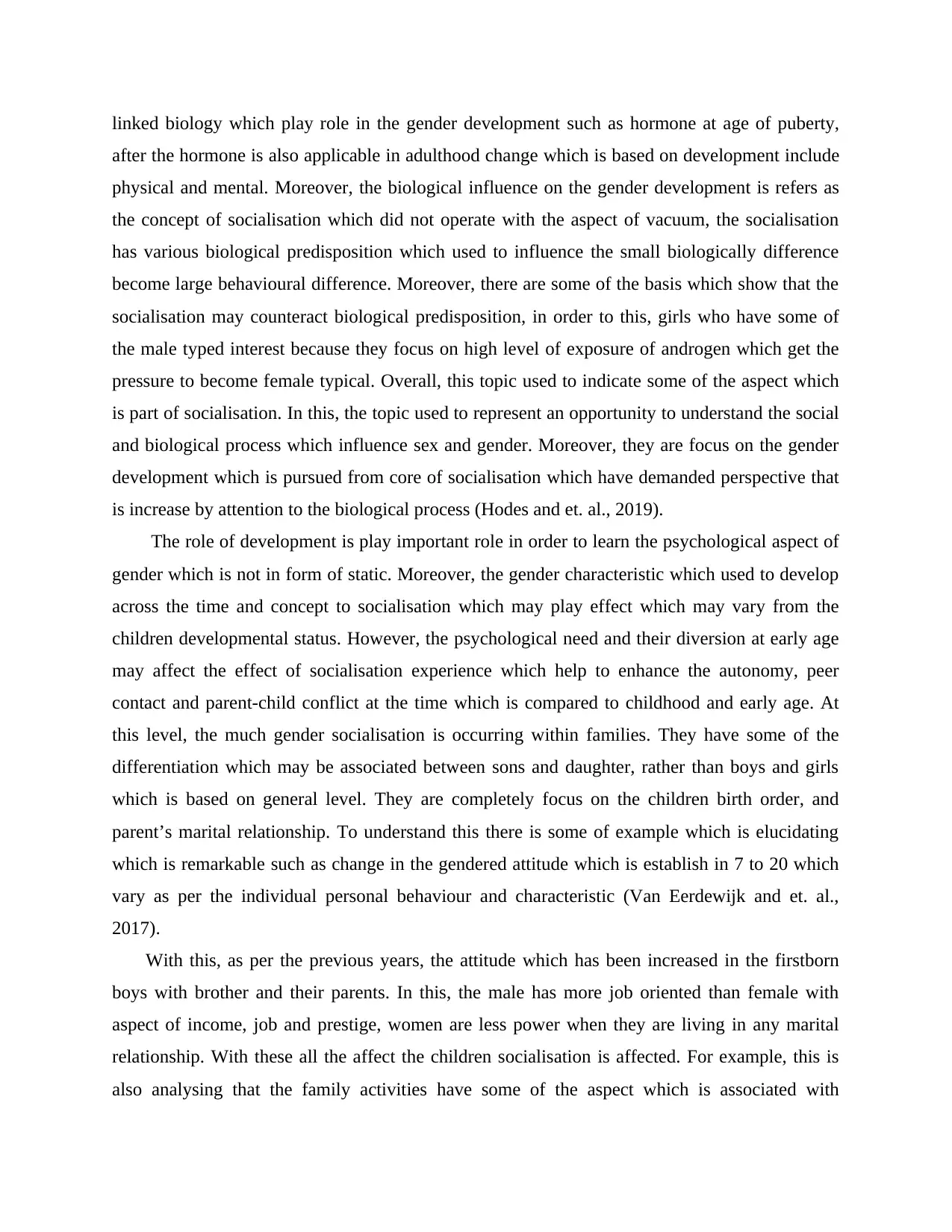
linked biology which play role in the gender development such as hormone at age of puberty,
after the hormone is also applicable in adulthood change which is based on development include
physical and mental. Moreover, the biological influence on the gender development is refers as
the concept of socialisation which did not operate with the aspect of vacuum, the socialisation
has various biological predisposition which used to influence the small biologically difference
become large behavioural difference. Moreover, there are some of the basis which show that the
socialisation may counteract biological predisposition, in order to this, girls who have some of
the male typed interest because they focus on high level of exposure of androgen which get the
pressure to become female typical. Overall, this topic used to indicate some of the aspect which
is part of socialisation. In this, the topic used to represent an opportunity to understand the social
and biological process which influence sex and gender. Moreover, they are focus on the gender
development which is pursued from core of socialisation which have demanded perspective that
is increase by attention to the biological process (Hodes and et. al., 2019).
The role of development is play important role in order to learn the psychological aspect of
gender which is not in form of static. Moreover, the gender characteristic which used to develop
across the time and concept to socialisation which may play effect which may vary from the
children developmental status. However, the psychological need and their diversion at early age
may affect the effect of socialisation experience which help to enhance the autonomy, peer
contact and parent-child conflict at the time which is compared to childhood and early age. At
this level, the much gender socialisation is occurring within families. They have some of the
differentiation which may be associated between sons and daughter, rather than boys and girls
which is based on general level. They are completely focus on the children birth order, and
parent’s marital relationship. To understand this there is some of example which is elucidating
which is remarkable such as change in the gendered attitude which is establish in 7 to 20 which
vary as per the individual personal behaviour and characteristic (Van Eerdewijk and et. al.,
2017).
With this, as per the previous years, the attitude which has been increased in the firstborn
boys with brother and their parents. In this, the male has more job oriented than female with
aspect of income, job and prestige, women are less power when they are living in any marital
relationship. With these all the affect the children socialisation is affected. For example, this is
also analysing that the family activities have some of the aspect which is associated with
after the hormone is also applicable in adulthood change which is based on development include
physical and mental. Moreover, the biological influence on the gender development is refers as
the concept of socialisation which did not operate with the aspect of vacuum, the socialisation
has various biological predisposition which used to influence the small biologically difference
become large behavioural difference. Moreover, there are some of the basis which show that the
socialisation may counteract biological predisposition, in order to this, girls who have some of
the male typed interest because they focus on high level of exposure of androgen which get the
pressure to become female typical. Overall, this topic used to indicate some of the aspect which
is part of socialisation. In this, the topic used to represent an opportunity to understand the social
and biological process which influence sex and gender. Moreover, they are focus on the gender
development which is pursued from core of socialisation which have demanded perspective that
is increase by attention to the biological process (Hodes and et. al., 2019).
The role of development is play important role in order to learn the psychological aspect of
gender which is not in form of static. Moreover, the gender characteristic which used to develop
across the time and concept to socialisation which may play effect which may vary from the
children developmental status. However, the psychological need and their diversion at early age
may affect the effect of socialisation experience which help to enhance the autonomy, peer
contact and parent-child conflict at the time which is compared to childhood and early age. At
this level, the much gender socialisation is occurring within families. They have some of the
differentiation which may be associated between sons and daughter, rather than boys and girls
which is based on general level. They are completely focus on the children birth order, and
parent’s marital relationship. To understand this there is some of example which is elucidating
which is remarkable such as change in the gendered attitude which is establish in 7 to 20 which
vary as per the individual personal behaviour and characteristic (Van Eerdewijk and et. al.,
2017).
With this, as per the previous years, the attitude which has been increased in the firstborn
boys with brother and their parents. In this, the male has more job oriented than female with
aspect of income, job and prestige, women are less power when they are living in any marital
relationship. With these all the affect the children socialisation is affected. For example, this is
also analysing that the family activities have some of the aspect which is associated with
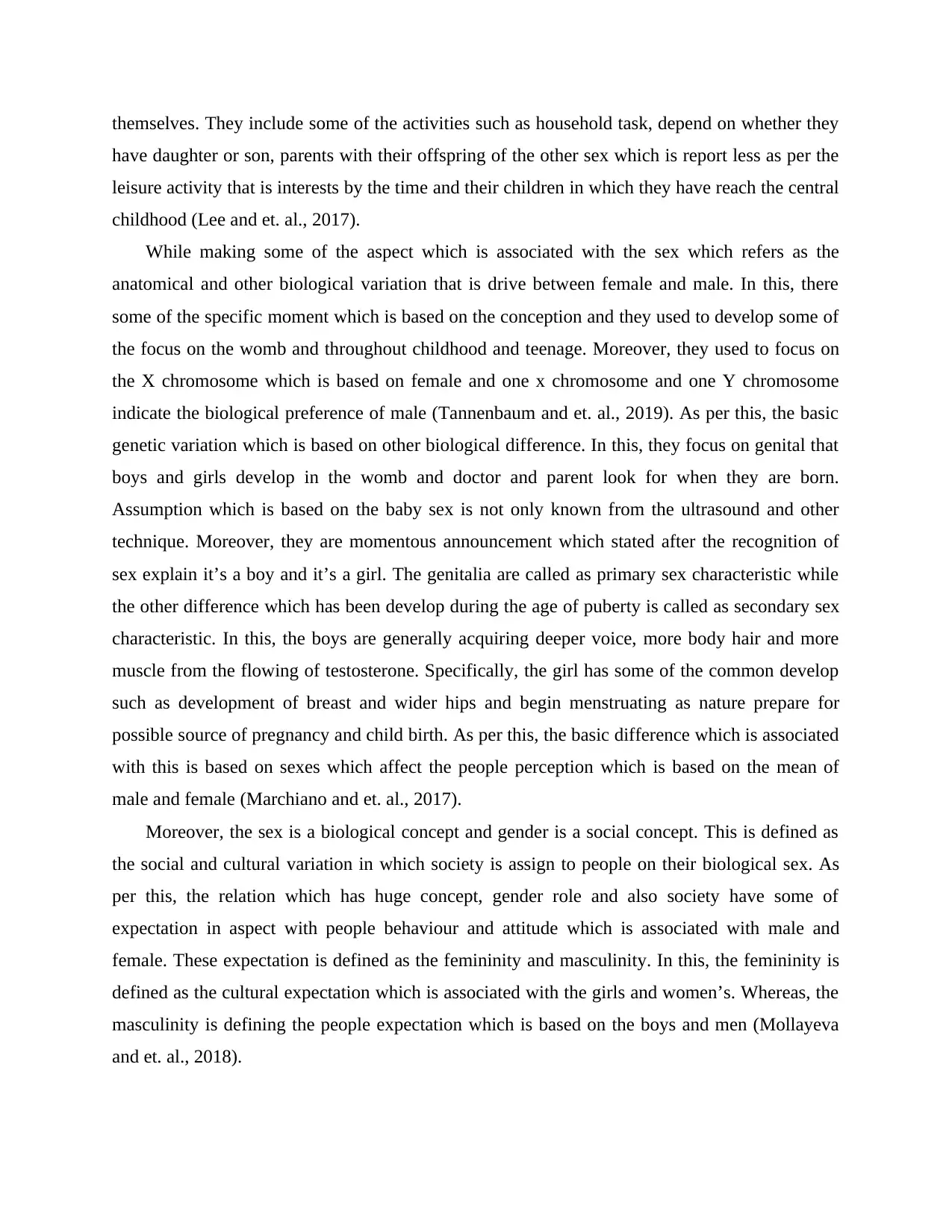
themselves. They include some of the activities such as household task, depend on whether they
have daughter or son, parents with their offspring of the other sex which is report less as per the
leisure activity that is interests by the time and their children in which they have reach the central
childhood (Lee and et. al., 2017).
While making some of the aspect which is associated with the sex which refers as the
anatomical and other biological variation that is drive between female and male. In this, there
some of the specific moment which is based on the conception and they used to develop some of
the focus on the womb and throughout childhood and teenage. Moreover, they used to focus on
the X chromosome which is based on female and one x chromosome and one Y chromosome
indicate the biological preference of male (Tannenbaum and et. al., 2019). As per this, the basic
genetic variation which is based on other biological difference. In this, they focus on genital that
boys and girls develop in the womb and doctor and parent look for when they are born.
Assumption which is based on the baby sex is not only known from the ultrasound and other
technique. Moreover, they are momentous announcement which stated after the recognition of
sex explain it’s a boy and it’s a girl. The genitalia are called as primary sex characteristic while
the other difference which has been develop during the age of puberty is called as secondary sex
characteristic. In this, the boys are generally acquiring deeper voice, more body hair and more
muscle from the flowing of testosterone. Specifically, the girl has some of the common develop
such as development of breast and wider hips and begin menstruating as nature prepare for
possible source of pregnancy and child birth. As per this, the basic difference which is associated
with this is based on sexes which affect the people perception which is based on the mean of
male and female (Marchiano and et. al., 2017).
Moreover, the sex is a biological concept and gender is a social concept. This is defined as
the social and cultural variation in which society is assign to people on their biological sex. As
per this, the relation which has huge concept, gender role and also society have some of
expectation in aspect with people behaviour and attitude which is associated with male and
female. These expectation is defined as the femininity and masculinity. In this, the femininity is
defined as the cultural expectation which is associated with the girls and women’s. Whereas, the
masculinity is defining the people expectation which is based on the boys and men (Mollayeva
and et. al., 2018).
have daughter or son, parents with their offspring of the other sex which is report less as per the
leisure activity that is interests by the time and their children in which they have reach the central
childhood (Lee and et. al., 2017).
While making some of the aspect which is associated with the sex which refers as the
anatomical and other biological variation that is drive between female and male. In this, there
some of the specific moment which is based on the conception and they used to develop some of
the focus on the womb and throughout childhood and teenage. Moreover, they used to focus on
the X chromosome which is based on female and one x chromosome and one Y chromosome
indicate the biological preference of male (Tannenbaum and et. al., 2019). As per this, the basic
genetic variation which is based on other biological difference. In this, they focus on genital that
boys and girls develop in the womb and doctor and parent look for when they are born.
Assumption which is based on the baby sex is not only known from the ultrasound and other
technique. Moreover, they are momentous announcement which stated after the recognition of
sex explain it’s a boy and it’s a girl. The genitalia are called as primary sex characteristic while
the other difference which has been develop during the age of puberty is called as secondary sex
characteristic. In this, the boys are generally acquiring deeper voice, more body hair and more
muscle from the flowing of testosterone. Specifically, the girl has some of the common develop
such as development of breast and wider hips and begin menstruating as nature prepare for
possible source of pregnancy and child birth. As per this, the basic difference which is associated
with this is based on sexes which affect the people perception which is based on the mean of
male and female (Marchiano and et. al., 2017).
Moreover, the sex is a biological concept and gender is a social concept. This is defined as
the social and cultural variation in which society is assign to people on their biological sex. As
per this, the relation which has huge concept, gender role and also society have some of
expectation in aspect with people behaviour and attitude which is associated with male and
female. These expectation is defined as the femininity and masculinity. In this, the femininity is
defined as the cultural expectation which is associated with the girls and women’s. Whereas, the
masculinity is defining the people expectation which is based on the boys and men (Mollayeva
and et. al., 2018).
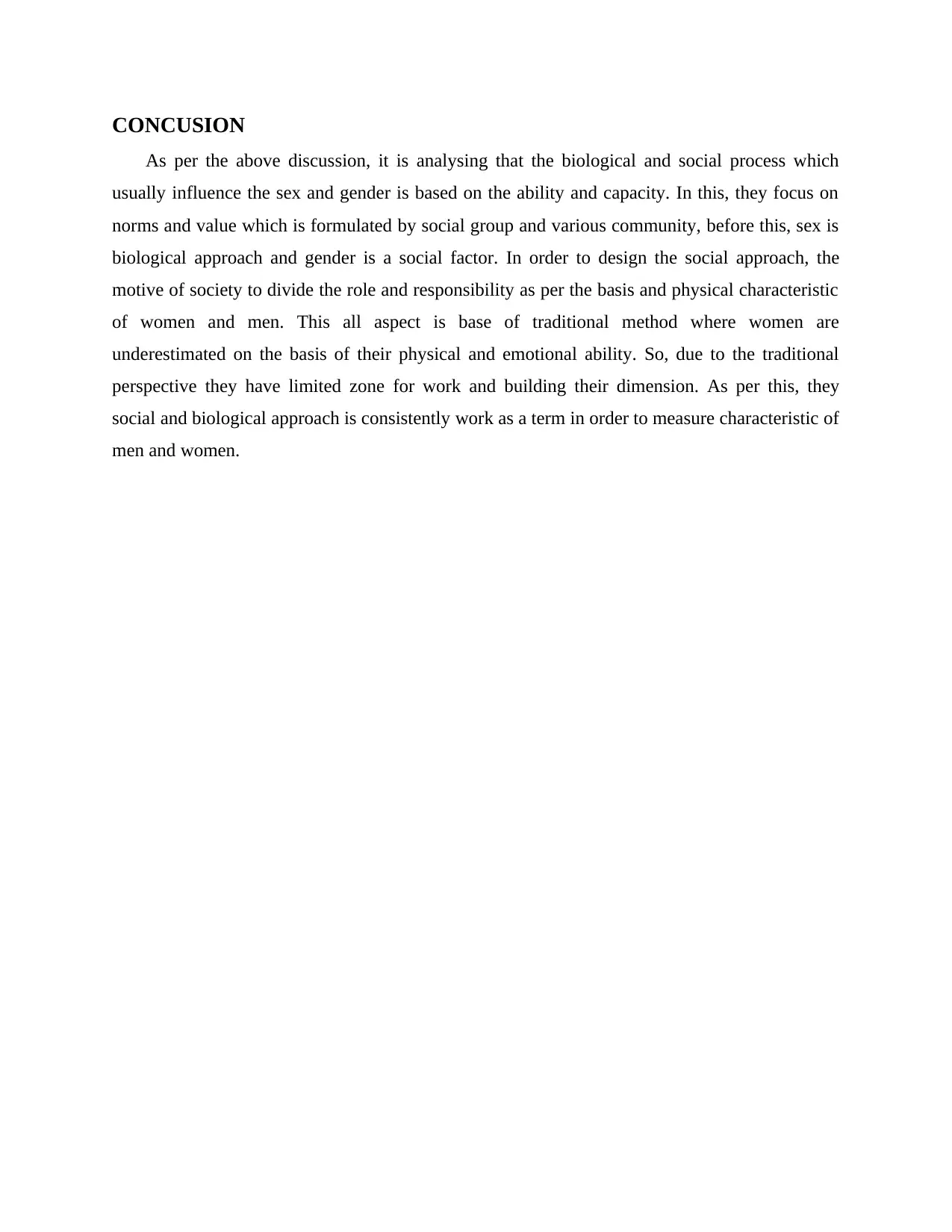
CONCUSION
As per the above discussion, it is analysing that the biological and social process which
usually influence the sex and gender is based on the ability and capacity. In this, they focus on
norms and value which is formulated by social group and various community, before this, sex is
biological approach and gender is a social factor. In order to design the social approach, the
motive of society to divide the role and responsibility as per the basis and physical characteristic
of women and men. This all aspect is base of traditional method where women are
underestimated on the basis of their physical and emotional ability. So, due to the traditional
perspective they have limited zone for work and building their dimension. As per this, they
social and biological approach is consistently work as a term in order to measure characteristic of
men and women.
As per the above discussion, it is analysing that the biological and social process which
usually influence the sex and gender is based on the ability and capacity. In this, they focus on
norms and value which is formulated by social group and various community, before this, sex is
biological approach and gender is a social factor. In order to design the social approach, the
motive of society to divide the role and responsibility as per the basis and physical characteristic
of women and men. This all aspect is base of traditional method where women are
underestimated on the basis of their physical and emotional ability. So, due to the traditional
perspective they have limited zone for work and building their dimension. As per this, they
social and biological approach is consistently work as a term in order to measure characteristic of
men and women.
Secure Best Marks with AI Grader
Need help grading? Try our AI Grader for instant feedback on your assignments.
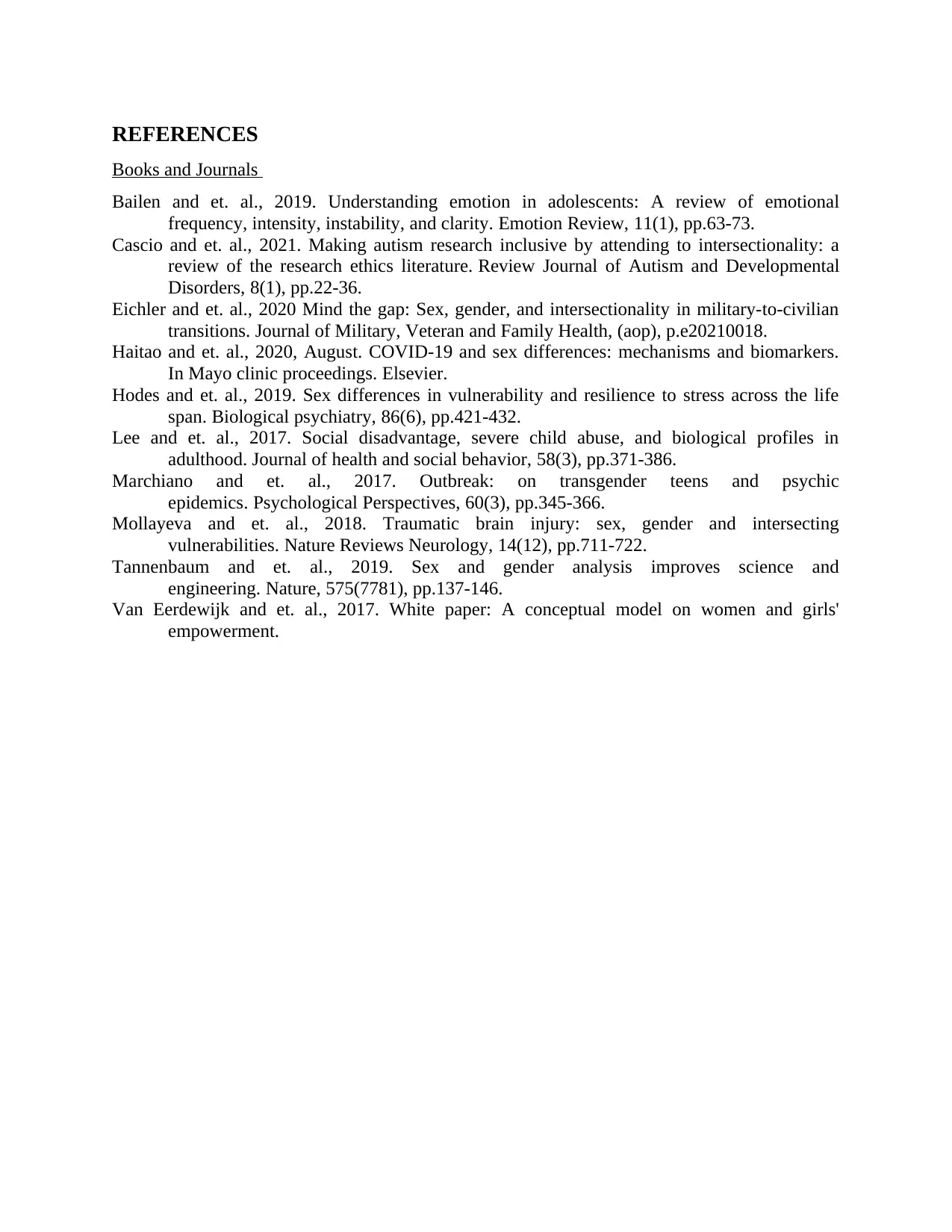
REFERENCES
Books and Journals
Bailen and et. al., 2019. Understanding emotion in adolescents: A review of emotional
frequency, intensity, instability, and clarity. Emotion Review, 11(1), pp.63-73.
Cascio and et. al., 2021. Making autism research inclusive by attending to intersectionality: a
review of the research ethics literature. Review Journal of Autism and Developmental
Disorders, 8(1), pp.22-36.
Eichler and et. al., 2020 Mind the gap: Sex, gender, and intersectionality in military-to-civilian
transitions. Journal of Military, Veteran and Family Health, (aop), p.e20210018.
Haitao and et. al., 2020, August. COVID-19 and sex differences: mechanisms and biomarkers.
In Mayo clinic proceedings. Elsevier.
Hodes and et. al., 2019. Sex differences in vulnerability and resilience to stress across the life
span. Biological psychiatry, 86(6), pp.421-432.
Lee and et. al., 2017. Social disadvantage, severe child abuse, and biological profiles in
adulthood. Journal of health and social behavior, 58(3), pp.371-386.
Marchiano and et. al., 2017. Outbreak: on transgender teens and psychic
epidemics. Psychological Perspectives, 60(3), pp.345-366.
Mollayeva and et. al., 2018. Traumatic brain injury: sex, gender and intersecting
vulnerabilities. Nature Reviews Neurology, 14(12), pp.711-722.
Tannenbaum and et. al., 2019. Sex and gender analysis improves science and
engineering. Nature, 575(7781), pp.137-146.
Van Eerdewijk and et. al., 2017. White paper: A conceptual model on women and girls'
empowerment.
Books and Journals
Bailen and et. al., 2019. Understanding emotion in adolescents: A review of emotional
frequency, intensity, instability, and clarity. Emotion Review, 11(1), pp.63-73.
Cascio and et. al., 2021. Making autism research inclusive by attending to intersectionality: a
review of the research ethics literature. Review Journal of Autism and Developmental
Disorders, 8(1), pp.22-36.
Eichler and et. al., 2020 Mind the gap: Sex, gender, and intersectionality in military-to-civilian
transitions. Journal of Military, Veteran and Family Health, (aop), p.e20210018.
Haitao and et. al., 2020, August. COVID-19 and sex differences: mechanisms and biomarkers.
In Mayo clinic proceedings. Elsevier.
Hodes and et. al., 2019. Sex differences in vulnerability and resilience to stress across the life
span. Biological psychiatry, 86(6), pp.421-432.
Lee and et. al., 2017. Social disadvantage, severe child abuse, and biological profiles in
adulthood. Journal of health and social behavior, 58(3), pp.371-386.
Marchiano and et. al., 2017. Outbreak: on transgender teens and psychic
epidemics. Psychological Perspectives, 60(3), pp.345-366.
Mollayeva and et. al., 2018. Traumatic brain injury: sex, gender and intersecting
vulnerabilities. Nature Reviews Neurology, 14(12), pp.711-722.
Tannenbaum and et. al., 2019. Sex and gender analysis improves science and
engineering. Nature, 575(7781), pp.137-146.
Van Eerdewijk and et. al., 2017. White paper: A conceptual model on women and girls'
empowerment.
1 out of 8
![[object Object]](/_next/static/media/star-bottom.7253800d.svg)





